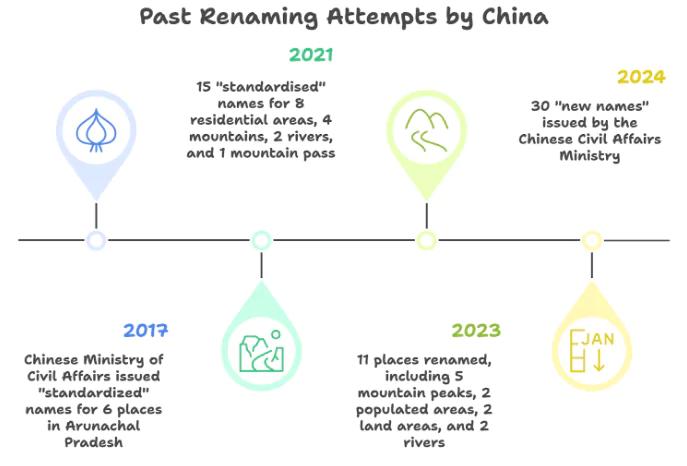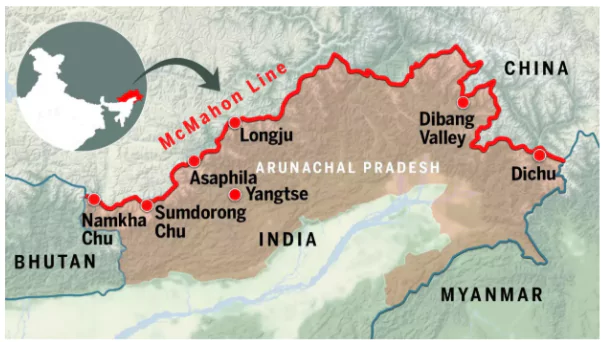Recently, India rejected the cartographic aggression of China over attempts to rename Arunachal Pradesh names in its own dialect.
- India reaffirmed that Arunachal Pradesh is an integral part of India.
What is Cartographic Aggression?
Cartographic aggression refers to the deliberate use of maps by a country to assert territorial claims over regions it does not actually control, with the aim of:
- Altering perceptions of ownership or sovereignty
- Justifying future claims or military actions
- Creating confusion or diplomatic pressure
|
- This is not a new strategy; China has periodically released lists with “standardised” Chinese names for places in Arunachal Pradesh since 2017.
- The Arunachal Pradesh Cabinet approved five mega hydropower projects with a combined capacity of 2,626 megawatts (MW) near the China border namely:
- Heo, Tato I, Tato II, Naying, and Hirong.
- The Heo and Tato I projects, both located on the Yarjep River

Historical Background of the Dispute
- The Simla Convention (1914) and the McMahon Line: Held between British India, Tibet, and China in Simla (now Shimla), British India.
- The McMahon Line was drawn as the boundary between British India and Tibet, placing Arunachal Pradesh (then NEFA) within British India.
 China’s Stand: The Chinese plenipotentiary initiated but later rejected the agreement.
China’s Stand: The Chinese plenipotentiary initiated but later rejected the agreement.
- China claims Tibet lacked sovereignty, hence had no legal authority to sign treaties.
- India’s Position: Recognizes the McMahon Line as the legal boundary.
- Chinese Annexation of Tibet (1950) and Implications
- People’s Liberation Army (PLA) entered Tibet in 1950.
- India expressed concern, but recognized Tibet as an autonomous region within China in 1954.
- China began asserting claims over areas south of the McMahon Line, including Arunachal Pradesh.
- This became the foundation of China’s claim on the state.
- India’s Administrative Integration of Arunachal Pradesh
- 1951: Major Ralengnao ‘Bob’ Khathing hoisted the Indian flag in Tawang, formally integrating the region.
- The North-East Frontier Agency (NEFA) was administered under Indian control.
- 1987: NEFA was renamed Arunachal Pradesh and granted full statehood in the Indian Union.
- 1962 Sino-Indian War: Triggered by escalating border tensions and Chinese objections to Indian infrastructure and patrols in disputed areas.
- In the eastern sector, PLA invaded and occupied Tawang and other areas but withdrew unilaterally after declaring a ceasefire.
- Revealed the extent of China’s strategic interest in Arunachal Pradesh, especially Tawang, for its historical and religious value.
- Post-1962 Developments: Border talks began in the 1980s but no formal settlement has been reached.
- 2005 Agreement: Both sides agreed that settled populations and interests must be taken into account — interpreted by India as safeguarding Arunachal’s status.
- However, China hardened its stance, especially post-2006, calling Arunachal “South Tibet” and protesting Indian leaders’ visits to the state.
China’s Claim and Justification over Arunachal Pradesh
- Historical-Cultural Linkages: China argues that Tawang and surrounding areas have historical, religious, and cultural ties with Tibet, particularly the Tawang Monastery‘s ties with Lhasa.
- The 6th Dalai Lama (Tsangyang Gyatso) was born in Tawang, and historical accounts show that the monastery maintained tribute and administrative connections with the Lhasa regime before 1951.
- China’s logic: since Tibet is under Chinese sovereignty, all regions historically affiliated with it — including Arunachal Pradesh — should be part of China.
- Rejection of the McMahon Line: The McMahon Line, drawn during the 1914 Simla Convention between British India and Tibet, demarcated the eastern boundary.
- China rejects the legality of the McMahon Line, claiming:
- Tibet was not a sovereign state and hence could not sign treaties.
- The boundary is a product of British imperialism and lacks legitimacy.
- China insists that accepting this line would mean legitimizing colonial aggression, which contradicts its official historical narrative.
- Use of Tibetan Autonomy for Strategic Assertion: China labels the entire state of Arunachal Pradesh as “Zangnan” (Southern Tibet).
- The Dalai Lama’s presence in India, and speculation that his successor could be identified from Tawang, is seen as a threat to China’s authority over Tibet.
- China uses territorial claims over Arunachal to counterbalance India’s Tibet card and to signal control over religious succession narratives.
- Domestic Nationalism and Political Legitimacy: With ideological decline of communism, the CCP has turned to nationalism as a source of legitimacy.
- Asserting claims on territories like Arunachal Pradesh fosters national pride, particularly in the wake of foreign policy criticism by netizens.
- Mass nationalism in China often demands a hard stance on “core issues” like Taiwan and Tibet, which extends to Arunachal.
- Military-Strategic Logic: Arunachal provides strategic depth in the eastern Himalayas.
- Control over Arunachal (especially Tawang) would give China:
- Advantageous topography against India.
- Ability to buffer Tibetan unrest by extending the frontier.
- China’s military deployments near Arunachal — including airfields, missiles, and rapid reaction forces (RRFs) — indicate its long-term interest in the area.
- Legal and Cartographic Warfare: China supports its claims with:
- Periodic renaming of places (2017, 2021, 2023, 2024, 2025).
- Maps labeling Arunachal as Chinese territory.
- Diplomatic protests and objections in international fora (e.g., ADB loan to Arunachal, 2009).
- This is part of a broader “Three Warfares” doctrine — psychological warfare, legal warfare, and media warfare — to alter international perceptions and assert “historical rights”.
- Comparison to Other Territorial Disputes: Similar tactics are used by China in the South China Sea (e.g., Spratly and Paracel Islands).
- By creating facts on the ground or in documentation, China attempts to normalize its claims internationally over time.
China’s Intentions Behind Renaming Places in Arunachal Pradesh
- Assertion of Sovereignty and Territorial Claim: Renaming places is part of China’s effort to assert a unilateral claim over Arunachal Pradesh, which it refers to as “Zangnan” (South Tibet).
- This symbolic assertion is intended to project de facto sovereignty over a region fully administered by India.
- Legal Warfare (Part of “Three Warfares” Doctrine): China uses “legal warfare” (falu zhan) — a strategy to alter international perceptions of disputed regions by issuing laws, maps, and names that claim foreign territories.
- The Geographical Name Regulations (1986, amended 2022) empower China’s Ministry of Civil Affairs to rename foreign territories as part of standard procedure.
- Goal: Create pseudo-legal evidence of long-standing administrative control, to be used in future border negotiations or international forums.
- Psychological and Propaganda Tool: Renaming undermines India’s sovereignty through symbolic psychological warfare, intended to:
- Confuse international observers about the status of Arunachal.
- Intimidate or demoralize India diplomatically.
- Convey to the global community that the territory is disputed, not settled.
- Diplomatic Signalling and Pressure: China often releases renaming lists immediately after Indian actions it opposes, such as:
- Dalai Lama’s visit to Tawang (2017)
- Visits by Indian PMs or Defence Ministers
- Approval of infrastructure projects in Arunachal
- This is a coercive diplomatic tactic aimed at dissuading India from further asserting its control or increasing its presence in the region.
- Example: After India’s inauguration of the Sela Tunnel project or Operation Sindoor, China escalated its naming efforts.
- Undermining the Tibetan Government-in-Exile: China views Tawang as a critical node in the Tibetan Buddhist network.
- If the next Dalai Lama is chosen from Tawang, it would undermine Beijing’s control over Tibetan succession.
- Renaming helps China reinforce its claim and attempt to delegitimize any Indian role in Tibetan religious affairs.
- Domestic Nationalism and Regime Legitimacy: Renaming territories serves domestic political goals:
- Fuels Han nationalist pride by standing up to India.
- Distracts from internal issues by invoking external threats.
- The ruling Communist Party uses such moves to reinforce regime legitimacy through symbolic victories.
- Strategic Precedent from Other Theaters: Similar tactics have been observed in:
- South China Sea (naming reefs, building artificial islands)
- East China Sea (Senkaku/Diaoyu Islands)
- The “name it to claim it” approach is a consistent geopolitical tool in Chinese foreign policy.
India’s Position on Arunachal Pradesh
- Legal and Constitutional Sovereignty: Arunachal Pradesh is a full-fledged Indian state since 1987 with a functioning legislature and governance.
- India asserts unquestionable sovereignty based on legal, administrative, and constitutional integration.
- Rejection of Chinese Renaming and Claims: India categorically rejects China’s renaming of places, calling it a “baseless and preposterous” attempt.
- The MEA reiterates that “invented names do not change the ground reality.”
- Adherence to McMahon Line: India accepts the McMahon Line as the legal boundary, drawn during the 1914 Simla Convention.
- It considers the boundary as settled and internationally accepted, despite China’s objections.
- Strategic and Infrastructure Development: India invests in border infrastructure: Sela Tunnel, roads, airstrips, and advanced landing grounds.
- These projects reinforce civilian presence and boost strategic deterrence in frontier areas.
- Diplomatic Consistency and Global Support: India maintains that no boundary negotiations can include Arunachal as a disputed territory.
- Strategic partners like the US, France, and Australia have explicitly supported India’s territorial claims.
- Military Readiness and Defensive Posture: India has deployed mountain strike corps, missile systems (e.g., BrahMos), and fighter jets in the region.
- The military build-up aims to defend sovereignty without escalating tensions.
Strategic Importance of Tawang
- Geopolitical Location: Located near the India–China–Bhutan trijunction in western Arunachal Pradesh.
- Close to the Line of Actual Control (LAC), making it a frontline region in India–China border dynamics.
- Military Significance: Controls key mountain passes like Sela Pass, critical for defense logistics.
- Vital for India’s military deployment and surveillance along the eastern Himalayan border.
- Dalai Lama Succession Factor: China fears the next Dalai Lama may be chosen from Tawang, challenging its control over Tibet.
- Raises the stakes in China’s territorial and religious claims over Arunachal Pradesh.
- Symbol of Indian Sovereignty: Regular visits by Indian leaders reaffirm administrative and political control.
- China’s protests over such visits highlight Tawang’s symbolic importance in bilateral tensions.
- Target of Chinese Claims: Tawang is often singled out by China in its reference to “South Tibet”.
- Seen as the most contested and sensitive zone within the broader border dispute.
Cultural and Religious Importance
- Birthplace of the 6th Dalai Lama: Tawang is the birthplace of Tsangyang Gyatso, the 6th Dalai Lama, in the 17th century.
- This historical fact gives Tawang deep spiritual significance in Tibetan Buddhist tradition and makes it a sacred site for Tibetans globally.
- Home to the Tawang Monastery: Tawang Monastery is the second-largest Tibetan Buddhist monastery after Lhasa.
- It has historically served as a religious, administrative, and cultural hub for the Monpa people and Tibetan Buddhism.
- Historical Linkages with Lhasa Monastery: Before 1951, Tawang Monastery maintained regular exchange of monks and paid tribute in barter to the Lhasa monastery.
- Judicial and land matters in Tawang were conducted using Lhasa-issued administrative directives.
- Religious Justification in Chinese Claim: China bases its territorial claim in part on the spiritual and historical ties between Tawang and Lhasa.
- Beijing argues that since Tibet is part of China, Tawang should also be integrated as “Southern Tibet”.
- Role in Dalai Lama Succession Politics: China fears the current Dalai Lama may identify his successor from Tawang, challenging China’s control over Tibetan Buddhism.
- If this happens, Tawang would become the focal point of spiritual authority outside Chinese influence.
- Symbol of Tibetan Identity and Resistance: Tawang remains a symbol of cultural resilience and religious continuity for the Tibetan community in exile.
- China views India’s facilitation of Tibetan religious freedom and the Dalai Lama’s visits to Tawang as a provocation and threat.
International Implications of Chinese aggression in Arunachal Pradesh
- Strategic Rivalry in the Indo-Pacific: The dispute reinforces the India–China geopolitical rivalry, especially within the broader Indo-Pacific strategic competition.
- India’s alignment with the Quad (US, Japan, Australia) is partially shaped by China’s actions in Arunachal Pradesh.
- U.S. and Western Recognition of India’s Position: The United States has openly recognized Arunachal Pradesh as part of India, especially in official Indo-U.S. joint statements.
- This contrasts sharply with China’s claim of “South Tibet” and increases diplomatic isolation of Beijing on this issue.
- Border Tensions Affecting Regional Stability: Recurring incidents at the LAC affect peace in South Asia, a region already prone to nuclear competition and border disputes.
- It complicates bilateral CBMs (Confidence Building Measures) and stymies boundary resolution talks.
- Multilateral Forums and India’s Stand: India has opposed China’s attempts to raise the Arunachal issue in multilateral institutions, like ADB in 2009.
- India emphasizes that development assistance in Arunachal is a sovereign decision.
- Diplomatic Friction and Bilateral Trade Tensions: Tensions over Arunachal often spill into diplomatic protests, visa bans for residents, and even trade barriers.
- China’s periodic objections to Indian leaders visiting Arunachal disrupt bilateral normalcy.
- China’s Global Image and Credibility: China’s cartographic aggression and renaming tactics reduce its credibility as a responsible global power.
- Other countries view such moves as revisionist and expansionist, similar to China’s behavior in the South China Sea.
Way Forward for India over Chinese aggression in Arunachal Pradesh
- Boost Border Infrastructure: Expedite construction of strategic roads, tunnels (e.g., Sela Tunnel), bridges, and airstrips in frontier areas.
- Ensure year-round access to remote border villages for both civilians and the armed forces.
- Strengthen Military Deterrence: Maintain enhanced deployment of Mountain Strike Corps, fighter squadrons, and missile systems in the eastern sector.
- Upgrade surveillance and logistics along the LAC to deter Chinese misadventures.
- Assert Diplomatic Stand Firmly: Continue rejecting Chinese renaming and false claims in global forums and bilateral talks.
- Publicly reiterate Arunachal Pradesh’s status as an integral and inalienable part of India.
- Engage Local Communities: Involve indigenous tribes in border governance, decision-making, and infrastructure projects.
- Ensure fair compensation and welfare under Local Area Development Funds for affected families.
- Promote Civilian Presence and Vibrant Villages: Expand schemes like the Vibrant Villages Programme to counter China’s border village model.
- Incentivize tourism, agriculture, and trade in border zones to ensure permanent civilian presence.
- Develop Energy Diplomacy Through Hydropower: Expedite implementation of hydropower projects (e.g., Heo, Tato I) with ecological safeguards.
- Use these projects to create local jobs, generate revenue, and assert economic control over remote areas.
- Strengthen Strategic Partnerships: Deepen defense and diplomatic cooperation with key partners like the U.S., Japan, Australia, and France.
- Use multilateral platforms to counter Chinese narratives and uphold India’s territorial integrity.
Conclusion
China’s renaming of places in Arunachal Pradesh is a strategic move to assert unilateral claims, which India firmly rejects, emphasizing Arunachal’s integral status. Strengthening infrastructure, military deterrence, and global alliances is crucial for India to counter China’s tactics and safeguard sovereignty.
Additional Readings: India China Relations, Deal on Easing LAC Tensions
![]() 15 May 2025
15 May 2025


 China’s Stand: The Chinese plenipotentiary initiated but later rejected the agreement.
China’s Stand: The Chinese plenipotentiary initiated but later rejected the agreement.
